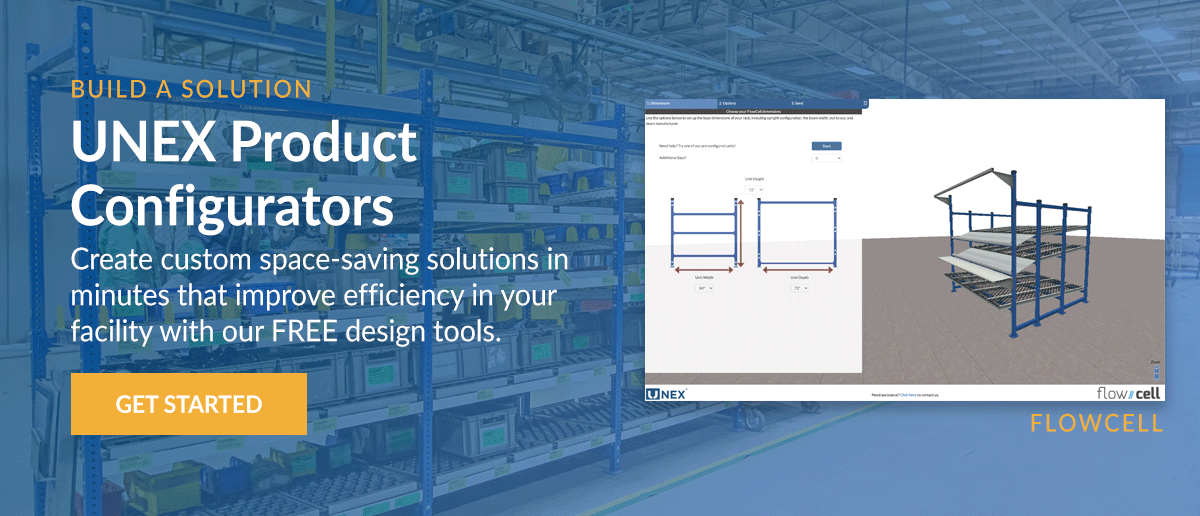The Best of Both Worlds: Maximize Fulfillment Efficiency by Integrating Robotics with Dynamic Storage

Advanced technologies such as collaborative robots (a.k.a. cobots), sensors, and machine learning are rapidly becoming the new normal in warehouses. These technologies play a major role in streamlining processes for maximum operational efficiencies. However, they aren’t without downsides. Advanced, more complex solutions tend to have a higher price tag and don’t scale as easily when a business experiences growth.
One way that companies can experience the best of both manual and automated solutions is by creating a hybrid or semi-automated picking environment. For fulfillment centers, this means investing in robotic solutions that work well alongside staff and dynamic storage solutions to enhance worker experiences and operational efficiency.
Unsure what this would look like? Here are a few examples of currently available robotic solutions that play well with UNEX storage solutions.
3 Robotic Solutions That Work Well with Dynamic Storage
1. Collaborative Robots and High-Density Storage
Warehouse collaborative mobile robots are gaining popularity in fulfillment centers, providing workers with robotic assistance when picking orders. The practice is called directed picking, where the robot literally tells the human worker where to go, what to pick, and also carries the items for them. It’s like a pace car that keeps things efficient during the picking process. This helps eliminate picking errors, which increases order accuracy and helps companies provide better customer experiences.
 When paired with cost-effective and extremely dense dynamic storage solutions like SpeedCell, for example, collaborative robots streamline the picking process. Dynamic high-density storage solutions like SpeedCell condense and organize inventory in an organized manner, making it easier for pickers, and their robotic assistants, to fulfill orders quickly.
When paired with cost-effective and extremely dense dynamic storage solutions like SpeedCell, for example, collaborative robots streamline the picking process. Dynamic high-density storage solutions like SpeedCell condense and organize inventory in an organized manner, making it easier for pickers, and their robotic assistants, to fulfill orders quickly.
2. Autonomous Robots and Modular Flow Racks
Unlike cobots, which tend to have a human component, autonomous robots can move and function within a fulfillment operation without a human operator. Using sensors and maps to interpret, navigate, and detect obstacles around the work environment, autonomous robots can perform basic functions on behalf of employees, freeing human workers for more important tasks.
A classic example of autonomous robotics in order fulfillment would be a robot designed to move a cart around a warehouse. In this scenario, the “cart” can take many forms, including a modular flow rack solution like FlowCell! For example, assembly plants may need to move full racks of inventory or parts line-side. This is where an autonomous robot could come in. By lifting the entire rack and its contents and seamlessly transporting it on behalf of workers, the workflow can continue uninterrupted.
3. Robotic Pickers and Carton Flow Rack
Robotic piece pickers mimic a human arm and can physically pick SKUs. While more complex tasks in the fulfillment process can be handled by humans, robotic arms are well-suited for more repetitive tasks like those found in piece picking applications. This frees up pickers for strategic initiatives and speeds processes.
Dynamic storage solutions, like the ones offered by UNEX, play nicely with a robotic arm like this because a robot still needs somewhere to pick from. For example, we’ve seen robotic arms picking from static industrial shelves. Fulfillment centers could improve on that scenario with a carton flow system like SpanTrack, which could more effectively hold and organize inventory for robotic arms to pick from while increasing space utilization throughout the facility.
Learn to optimize warehouse space for increased speed and accuracy. Download the Guide to Understanding Throughput for Fulfillment!

UNEX Products That Power the Hybrid Warehouse
Creating a hybrid warehouse that merges human efficiency with automation requires more than just cutting-edge tech — it also depends on smart infrastructure that supports and enhances those systems. That’s where UNEX comes in. Our dynamic storage solutions are not only built to optimize manual workflows, but they also integrate seamlessly with collaborative, autonomous, and robotic technologies for greater throughput and accuracy.
Here’s how the UNEX products featured in this article align with today’s most innovative warehouse environments:
 SpeedCell
SpeedCell
SpeedCell high-density storage, offers textile-based shelving system that is a perfect match for collaborative picking robots. With clear visual organization, ergonomic access, and up to 60% more storage capacity within standard racking, SpeedCell helps both human workers and their robotic “co-pilots” quickly locate and pick SKUs with minimal travel time. It enhances directed picking workflows and enables faster, more accurate order fulfillment — all while maximizing your current warehouse footprint.
 FlowCell
FlowCell
FlowCell is a modular flow rack system that can be customized to fit assembly and kitting processes. Its mobility and flexibility make it ideal for integration with autonomous mobile robots (AMRs), which can move full racks line-side or between workstations. Whether you’re using FlowCell as a mobile pick station or a transportable inventory rack, it works in harmony with AMRs to reduce manual material handling and improve overall workflow continuity.
 SpanTrack
SpanTrack
SpanTrack carton flow systems provide the structured, gravity-fed pick environment that robotic arms need for speed and precision. Whether you’re using full-width SpanTrack Lane for consistent, high-volume SKUs or SpanTrack Wheel Bed for varied SKU sizes and flexible slotting, both configurations offer FIFO rotation and maximum pick-face utilization. SpanTrack ensures that robotic pickers are always operating at peak efficiency — no searching, no clutter, just fast and organized picking.
Increase Productivity with a Hybrid Work Environment
Industry 4.0 isn’t an all-or-nothing scenario. Warehouses and fulfillment centers need to shave seconds off their pick times and fulfillment rates and merging dynamic storage with new technology is a way to do that. With both manual and automated warehouse systems becoming more advanced, streamlining order fulfillment processes with them is becoming increasingly popular.
UNEX dynamic storage systems integrate with all kinds of warehouse solutions, including automation and robots. If you're considering a switch to automation, keep in mind you can pair them with dynamic UNEX solutions for a robust warehouse system.
Looking to increase productivity in your fulfillment center? Connect with a space optimization specialist to learn more about how our dynamic storage solutions can work with your robotics systems.



